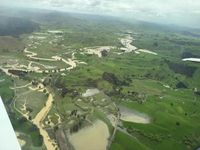Residents of Newcastle, County Down, found themselves battling nature’s fury over the weekend as torrential rain sent floodwaters gushing down from the Mourne Mountains, turning roads into rivers and leaving a trail of destruction in its wake. On Sunday, October 19, 2025, two days of relentless rainfall culminated in what many locals described as the worst flooding they’d ever witnessed, especially along Tullybrannigan Road, which bore the brunt of the disaster.
According to BBC News NI, the flooding unfolded rapidly, with surface water run-off from the mountains sweeping large stones and debris onto residential streets. The Department for Infrastructure (DfI) reported that more than 900 sandbags were deployed as emergency crews and residents scrambled to stem the rising waters. Despite their efforts, roads were left cracked, gardens inundated, and several homes damaged.
Debbie Biggerstaff, a resident of Tullybrannigan Road, recounted the chaos: “The road was just crumbling and it was so dangerous crossing the road and it almost took you out under your feet,” she told Downtown Radio & Cool FM. “The water had been going into the gardens and the garages. So we managed to lift all the debris with shovels and spades and build a wall with sandbags and stones.” She emphasized the community’s resilience, noting, “We gathered together, with wheelbarrows and picked up debris and helped to protect neighbours... all the neighbours pulled together.”
But the ordeal was not just about physical damage. Many residents spoke of the fear and uncertainty that gripped the community as the water levels rose. Karen Enmel, visiting from Carlingford, said, “The water just wasn’t going anywhere. My uncle lives in the area and he said it’s the first time in 30 years that he has ever experienced this. I was scared myself – I really was.”
For Liz McLaughlin, who has lived in Newcastle for more than four decades, the scale of the flooding was unprecedented. “It came out of the forest like a torrent... my walls were like a waterfall and my garden was like a swimming pool. The stones that passed here were quite big, they were just ripping up the road, big chunks of tarmac.” She expressed concern for her neighbors but was grateful for the swift response from all agencies involved.
The immediate aftermath saw Tullybrannigan Road closed as diggers and road workers continued the arduous task of clearing debris and repairing damaged infrastructure. The Police Service of Northern Ireland (PSNI) urged caution, warning that conditions remained hazardous. The yellow weather warning, issued by the Met Office for counties Antrim, Armagh, and Down, had been extended until 3pm on Sunday and widened to include parts of Londonderry and Tyrone, underscoring the severity and unpredictability of the weather event.
While the low tide helped disperse some of the rainwater, the sheer volume of debris – including large stones and even chunks of tarmac – blocked drains and exacerbated the flooding. The DfI confirmed that the flooding was not due to river overflow but rather surface water run-off from the Mournes after heavy overnight rain. Their teams, “on standby all weekend following the Met Office weather warning,” worked alongside residents to clear roads and deploy sandbags.
As the clean-up continued into Monday, October 20, 2025, calls for accountability and long-term solutions grew louder. First Minister Michelle O’Neill described the scenes as “devastating” and praised the responders who helped protect communities. She added, “The executive will have to discuss how it can best support those impacted but for now all the effort and energy is being placed in the immediate response.”
Political leaders across the spectrum echoed the need for urgent investigation and permanent flood prevention measures. DUP MLA Diane Forsythe stated, “We need an urgent investigation as to why this has happened here. The amount of debris also that has fallen is quite frightening, we can see from the clean up the diggers are out today it’s absolutely terrifying.” She questioned the effectiveness of existing flood alleviation schemes, asking, “Has it made things better or has it moved everything to a different part of Newcastle? There has to be some solution we can find here.”
Sinn Féin MLA Cathy Mason added, “Everything needs to be looked into. It’s very clear it was just staggering... we’ve never seen images like this before and it’s unfortunate we can see events like this becoming more regular. It’s clearly having a negative effect on, I suppose, the mental health of these households. We can’t have that, we can’t have people living in fear.”
Sam Anderson, from the Newcastle Regional Community Resilience Group, voiced frustration over the reliance on temporary fixes. “Temporary solutions have been put in place in recent years as parts of Newcastle have been hit hard by flooding. A temporary pump was used over the weekend that probably saved homes but it’s a temporary solution. As residents we want permanent solutions.” He criticized the lack of maintenance on rivers, gullies, and flood protection flaps, saying, “We want to see some action… what’s the point in us spending time talking to people? We want action... to help get the problem solved.”
The community’s concerns are not without precedent. In 2020, Newcastle was severely affected by flooding after Storm Francis, leading to the evacuation of elderly residents and the launch of the Shimna River Scheme. This flood alleviation project, begun in 2021, aimed to protect more than 300 properties through a combination of flood defense systems, including continuous interlocking walls and embankments. Despite these efforts, many residents feel that more comprehensive, long-term strategies are needed to prevent future disasters.
For now, the Tullybrannigan Road remains closed, and the clean-up operation continues, with diggers clearing debris and agencies assessing the full extent of the damage. The Department for Infrastructure has urged anyone impacted by the floods to contact the Flood Incident Line to request sandbags and support.
As Newcastle’s residents come to terms with the aftermath, their calls for lasting change ring louder than ever. The weekend’s events have laid bare the vulnerabilities in local infrastructure and the pressing need for coordinated, permanent solutions to the growing threat of severe weather. For many, the memory of water rushing through their streets and homes will not soon be forgotten, and neither will their determination to ensure it doesn’t happen again.





